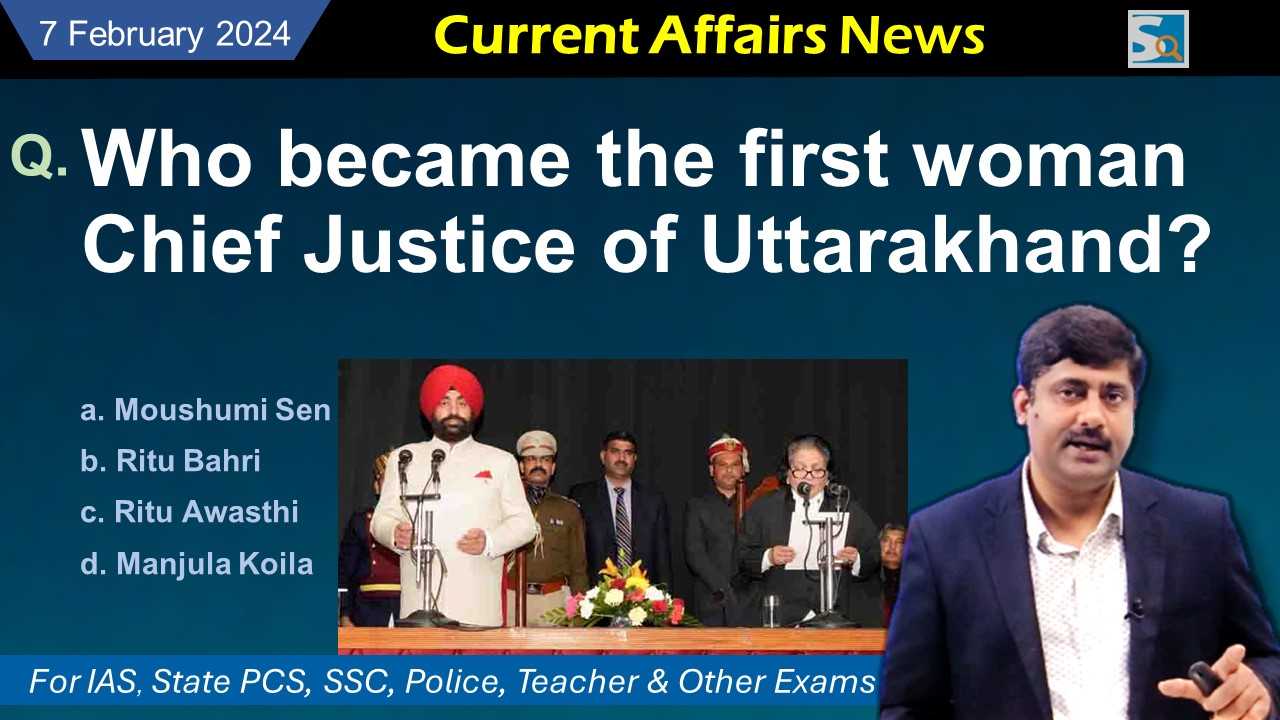This is the current affairs of 7 February 2024. Here are questions and answers of daily current affairs for better preparation of competitive exams for government jobs.
PDF Download: Click here
1. Which state government introduced the Uniform Civil Code (UCC) Bill in the Assembly?
a. Uttar Pradesh
b. Bihar
c. Uttarakhand
d. Madhya Pradesh
Answer: c. Uttarakhand
– On February 6, 2024, Chief Minister Pushkar Singh Dhami presented the Uniform Civil Code (UCC) bill in the Uttarakhand Legislative Assembly.
– After the bill is passed, Uttarakhand will become the first state in independent India to implement the UCC.
What is the Uniform Civil Code (UCC)?
– Typically, there are two types of laws in the country – criminal law and civil law.
Criminal Law:
– It deals with criminal cases such as theft, robbery, assault, murder, and fraud.
– It provides for a uniform court, process, and punishment for all religions or communities.
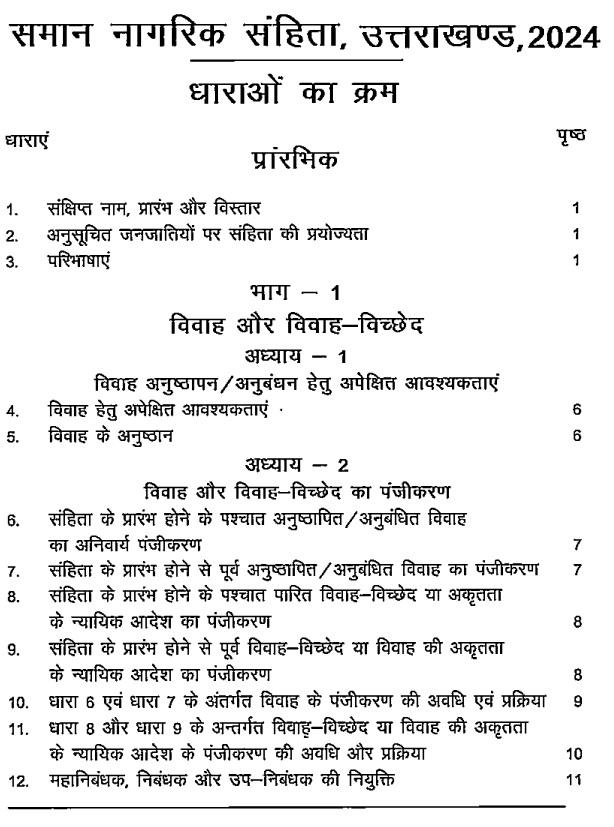
Civil Law:
– It deals with matters related to marriage, property, etc.
– In India, customs, traditions, culture, and practices hold importance in matters related to marriage, family, and property.
– This is why such laws are also referred to as personal laws.
– For example, in Muslim personal law, the division of property and marriage is governed by Muslim Personal Law.
– Whereas Hindu marriage is governed by the Hindu Marriage Act. Similarly, there are separate personal laws for Christians and Sikhs.
Uniform Civil Code (UCC):
– It provides for the abolition of personal laws and the enactment of a uniform law for everyone.
– That is, there will be a uniform law for every citizen residing in Uttarakhand, regardless of their religion or caste.
– For example – under personal law, Muslim men can have four wives, but under the Hindu Marriage Act, it is a crime to marry again while the first wife is alive.
– So, there will be one law that both religious communities will have to abide by.
– However, the draft of the new law by the Uttarakhand government is keeping the tribals separate from it.
————–
2. The provisions of the Uttarakhand Government’s ‘Uniform Civil Code’ Bill will not apply to which of the following?
a. Muslim
b. Hindu
c. Tribal
d. Jain
Answer: c. Tribal
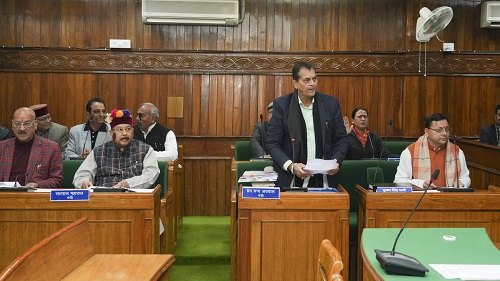
– The provisions of this bill will not be applicable to tribal communities.
– Among these tribal communities are Tharu, Boksa, Raji, Bhotia, and Jaunsari communities.
– The bill states that, “Any provision contained in this code shall not apply to members of any Scheduled Tribe and the individuals and groups within them whose traditional rights are protected under Article 21 of the Constitution of India read with clause (25) of Article 366.”
Provisions of the Uniform Civil Code (UCC) Bill:
Rules for Live-in Relationships:
– Registration is required for living in a live-in relationship. Termination (ending the relationship) also needs to be registered.
– For living in a live-in relationship without registration for more than a month, imprisonment of up to three months or a fine of up to ₹10,000 or both may be imposed.
Prohibition on Polygamy:
– During marriage, neither party should have a living spouse.
– Polygamy or polygamous marriage is prohibited.
– Marriage registration (at the local body) will be mandatory.
– Remarriage will be restricted under any condition (such as halala, iddat).
Minimum Age for Marriage for Men and Women:
– The eligible age for marriage for men and women is 21 and 18 years respectively.
– Marriage is prohibited between certain relatives such as cousins, uncles, aunts, nephews, nieces, but if such a marriage is already accepted and valid in any religion, it will be permitted.
Equal Rights for Girls in Parental Property:
– It is stated in the new law draft that both sons and daughters will have equal rights in parental property.
Responsibility of Husband for In-Laws in Case of Wife’s Death:
– The new law states that if a wife dies and her parents have no support, then the husband will be responsible for their maintenance.
Simplified Adoption Process:
– According to the new law, everyone will have the right to adoption. Additionally, the process of guardianship will be simplified in the case of orphaned children.
Uttarakhand:
Chief Minister – Pushkar Singh Dhami
Governor – Gurmeet Singh
Capital – Dehradun and Gairsain (Summer)
————–
3. The Central Government decided to install fencing on the 1643 km long border between India and which neighboring country?
a. China
b. Myanmar
c. Sri Lanka
d. Bhutan
Answer: b. Myanmar
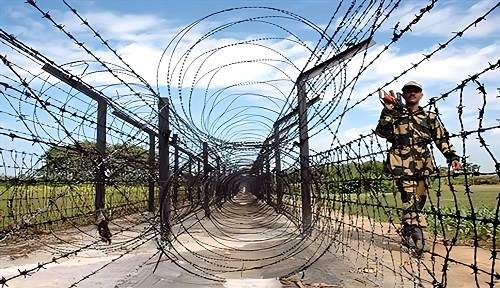
– The central government will install fencing along the 1643-kilometer-long India-Myanmar border.
– This border is connected to the Indian states of Mizoram, Manipur, Nagaland, and Arunachal Pradesh.
– A patrol track will also be constructed for better surveillance along the border.
– Home Minister Amit Shah mentioned that fencing has already been installed in Moreh, Manipur, which is 10 kilometers from the total length of the border.
– Additionally, two pilot projects for installing fences through the Hybrid Surveillance System (HSS) are being implemented.
– Fencing will be done at every kilometer distance in Arunachal Pradesh and Manipur. Approval has also been given to fence up to approximately 20 kilometers in Manipur, and work will commence soon.
Why Fencing:
– The central government is considering ending the Free Movement Regime (FMR) with Myanmar to prevent the entry of illegal infiltrators and insurgents into India.
Myanmar:
Capital – Naypyidaw
Former Name – Burma
President – Myint Swe
Prime Minister and Commander-in-Chief – Min Aung Hlaing
————–
4. केंद्र सरकार किस पड़ोसी देश के मुक्त आवाजाही व्यवस्था (FMR) खत्म करने पर विचार कर रही है?
The Central Government is considering ending the Free Movement Regime (FMR) of which neighboring country?
a. Nepal
b. Bhutan
c. Myanmar
d. Sri Lanka
Answer: c. Myanmar
What is the Free Movement Regime (FMR)?
– FMR is a mutual agreement between India and Myanmar, which allows indigenous tribes residing on both sides of the border to travel up to 16 kilometers into the other country without a visa.
– It was implemented in 2018 as part of the Act East Policy of the Narendra Modi government, at a time when diplomatic relations between India and Myanmar were improving.
Why was FMR implemented?
– According to the Indian Express, the demarcation of the border between India and Myanmar was done by the British in 1826 without consulting the people residing in the region.
– The border effectively divided people of the same ethnicity and culture across both countries without their consent.
– The current India-Myanmar border reflects the line drawn by the British.
– There are strong ethnic and familial ties among the people in this region.
– In Manipur’s Moreh area, there are villages where some houses are located in Myanmar.
– In Mon district of Nagaland, the border passes right through the house of the headman of the Longwa village, dividing his home into two parts.
– Besides facilitating contact between people, FMR was also intended to promote local trade and business.
– Border trade has a long history through border taxes and border haats in this region.
Considering the low-income economy, such exchanges are crucial to sustain local livelihoods.
– For the border communities in Myanmar as well, Indian cities are closer for business, education, and healthcare compared to their own country.
So why is there debate on FMR now?
– The illegal migration of Kokki-Chin people from Myanmar to Manipur is one of the major issues fueling conflict in the state.
– While the Meitei people have accused these illegal migrants of creating disturbance in the state and allegedly being part of a “narcoterrorist network” on the India-Myanmar border (IMB).
– Amidst this alleged and sensitive debate in the state, questions have been raised on FMR.
– While it is beneficial for local people and aids in improving India-Myanmar relations, criticism has been raised in the past for inadvertently aiding illegal immigration, drug trafficking, and unknowingly assisting in gunrunning.
————–
5. Telangana state government has decided to change the abbreviation of the state to TS, what will be the new name?
a. TG
b. GG
c. TSG
d. TL
Answer: a. TG
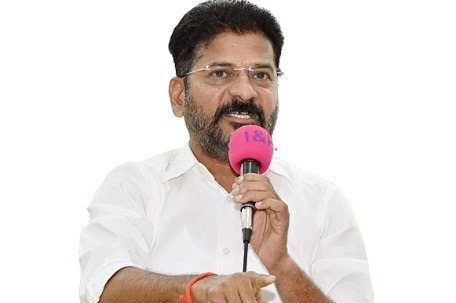
– The Telangana cabinet, under the chairmanship of Chief Minister Revanth Reddy, has decided to change the abbreviated name of their state in its meeting on February 5, 2024.
– Following the cabinet’s decision, the abbreviation in the central government’s Gazette will be changed from TS to TG.
– Telangana state was formed in the year 2014.
– The current government alleges that the previous government, the Telangana Rashtra Samithi (TRS), changed the state’s abbreviated name from ‘TG’ to ‘TS’ to align with their party’s initials, which is incorrect.
————–
6. Telangana government decided to change the national anthem, what is the new anthem?
a. Telangana is ours
b. Telangana of India
c. Indian Telangana
d. Jaya Jaya Ho Telangana
Answer: d. Jaya Jaya Ho Telangana
– In the cabinet meeting, it was also decided to change the state anthem.
– Now, Andre Sri’s “Jaya Jaya Ho Telangana” will be made the state anthem.
The symbolic goddess of the state, – Telangana Talli, will also be reimagined in a new form.
Telangana:
Capital – Hyderabad
Chief Minister – Revanth Reddy
Governor – Tamilisai Soundararajan
————–
7. In which state did PM Modi lay the foundation stone of Maa Kamakhya Corridor in February 2024?
a. Mizoram
b. Meghalaya
c. Nagaland
d. Assam
Answer: d. Assam
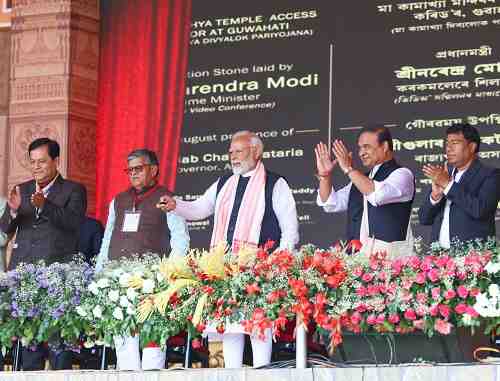
– Prime Minister Narendra Modi laid the foundation stone of the Maa Kamakhya Corridor (costing 498 crores) in Assam on February 4, 2024.
– Along with this, he also inaugurated projects in Assam totaling more than 11 thousand crores.
Maa Kamakhya Devi Corridor:
– Besides the Maa Kamakhya Devi temple on the Nilachal Hill in Assam, there are several other temples.
– Surrounding the hill are five temples of Lord Shiva: Kameshwar, Siddheshwar, Kedareshwar, Amartokeshwar, Aghora, and Kautiling.
– All these temples will be connected to form the Maa Kamakhya Corridor.
– The Nilachal is formed by three parts: Brahma Hill, Vishnu Hill, and Shiva Hill.
Assam:
Capital – Dispur
Chief Minister – Himanta Biswa
Other Temple Corridors in the Country:
– Jagannath Temple Heritage Corridor, Puri (Odisha): Cost 800 crores – Inaugurated on January 17
– Kashi Vishwanath Temple Corridor, Varanasi (UP): Cost 332 crores – Inaugurated on February 14, 2022
– Mahakal Lok, Ujjain (Madhya Pradesh): Cost 850 crores – Inaugurated on October 11, 2022
– Banke Bihari Temple Corridor: Cost 262 crores – Work in progress
– Devbhumi Corridor, Dwarka (Gujarat) – Work in progress.
—————
8. Which Russian astronaut made the world record for spending the most time in space?
a. Frank Rijkaard
b. Oleg Kononenko
c. Yelena Kondakova
d. Yelena Serova
Answer: b. Oleg Kononenko

– Russian cosmonaut Oleg Kononenko completed this record on February 4, 2024.
– Oleg Kononenko has set a record for spending the most 879 days in space.
– He has broken his own countryman Gennady Padalka’s record of 878 days, 11 hours, and 30 minutes spent in space.
Target: Spending 1000 days in space
– The Russian space agency Roscosmos has posted on Telegram, stating that Oleg will be sent to the space station again on June 5, 2024.
– Then he will become the record holder for spending 1000 days in space.
– As soon as his journey is completed on September 23, 2024. He will have spent 1110 days in space.
Note – Those who travel in space are called cosmonauts by Russians, while Americans call them astronauts. In India, Indian space travelers are called vyomanauts.
—————
9. When was Safer Internet Day celebrated in the year 2024?
a. 3 February
b. 4 February
c. 5 February
d. 6 February
Answer: d. 6 February

Theme of 2024:
– Together for a Better Internet
– Safe Internet Day is celebrated every year on the second day of the second week of February.
– In the year 2024, it was observed on February 6th.
– While in 2025, it will be celebrated on February 11th.
– This day is observed every February to raise awareness about safe and better internet for children and youth.
————-
10. Who became the first woman Chief Justice of Uttarakhand?
a. Mausumi Sen
b. Ritu Bahri
c. Ritu Awasthi
d. Manjula Kokila
Answer: b. Ritu Bahri
– On February 4, 2024, Justice Ritu Bahri took oath as the first female Chief Justice of the Uttarakhand High Court.
– Lieutenant General Gurmeet Singh (Retired), the Governor, administered the oath to her at the Raj Bhavan.
– Prior to this, Ritu Bahri served as the Acting Chief Justice of the Punjab and Haryana High Court.

